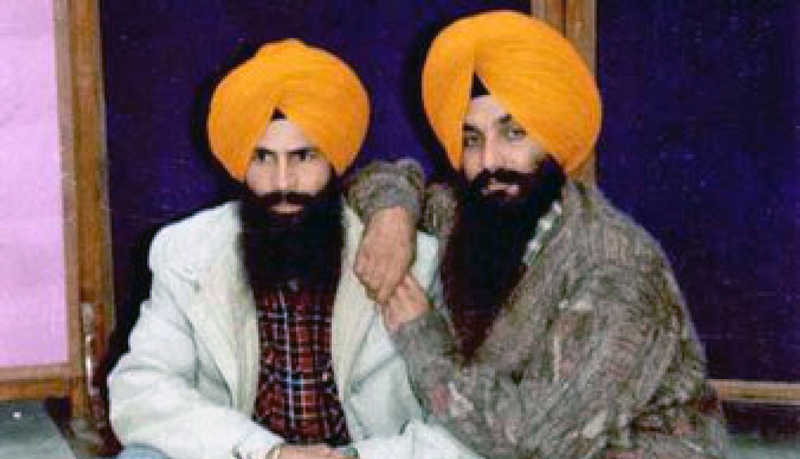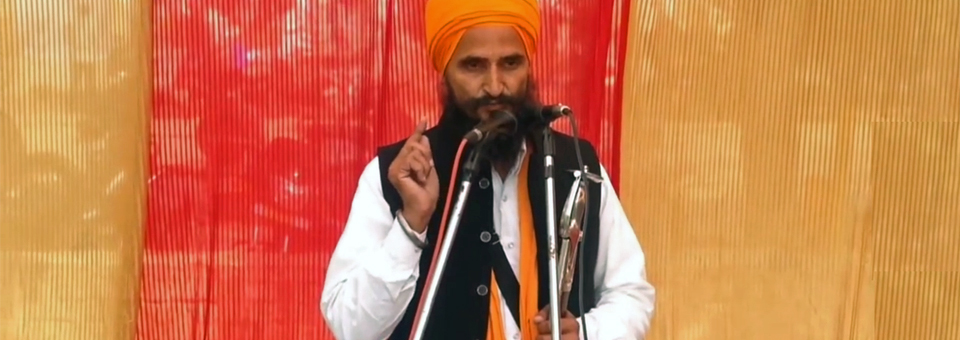Sukhdev Singh Sukha and Harjinder Singh Jinda are two names synonymous with the Sikh freedom struggle, whose iconic embrace captured in a photograph from the early 1990s epitomises the enduring Sikh spirit, and cemented their status as 20th century legends. Feared by the Indian State, they were consequently demonised by the Punjabi State press and executed on 9 October 1992. For a number of years now, not only has the the Akal Takht made an Ardas in their memory on this day, but has honoured surviving members of their family for the sacrifice of their kin. As we move farther from the immediate fall-out of 1984 into a Sikh World that is increasingly ignorant of the underlying issues to 20th century Punjabi politics and events, Sukha and Jinda continue to live on, romanticised for the large part, but remembered nevertheless, even by those who weren’t born at the time of their shaheedi. At this juncture then, it is insightful to consider what the successors of Bhai Sukha and Bhai Jinda might look like today, and for the purposes of provoking that conversation, I am authoring this article.
Twenty-four years ago when we came to learn that Bhai Sukha and Bhai Jinda had become shaheed, my family along with a few others held a Sukhmani Sahib service at our local Gurdwara in Hitchin, North Hertfordshire; it was not well attended. By the early 90’s, many everyday Sikhs from within congregations up-and-down the country had grown weary of hearing about the struggle, and under the influence of a constant stream of propaganda from what little media existed at the time, had begun to question the movement’s base in their newly adopted homes of the West. Matters weren’t helped by the politics being played out from non-Khalistani Sikhs wrestling for control of many leading Gurdware that had occurred in the years prior to the execution, as well as the divisions that had arisen within the International Sikh Youth Federation (ISYF) itself. Still, ours was a relatively small community that had always punched above its weight, and in hindsight, this was one of my earliest recollections of witnessing a downturn in the movement. It is ironic that today, many of the young people who frequent that particular Gurdwara are the offspring of Sikhs who at the time stayed away, and in hushed tones had begun to talk of us and the movement as extremist. It’d be interesting to hear those from my home town who consider Sukha and Jinda as role models, asking their parents and grandparents about the part they played in local Gurdwara politics circa 1992, and in response to see how perhaps now their elders’ attitudes have also changed.
My home town is not alone: a new generation of Sikhs residing across the globe talk freely about Bhai Sukha and Bhai Jinda, helped in no small part by the internet which has played a vital role to embed the duo into contemporary Sikh culture. This appears in various guises from photographs of the pair captured throughout their adult lives, to reprints of the letters that they wrote from prison. Written work best exemplified by the Lighthouse Collective’s ‘Labh’ rewrites the English-language narrative on the freedom struggle and the personalities behind it, giving rise to shorter biographies and social media eulogies that translate the message year after year to new seekers. A work of music by Toronto artists Noyz and B Magic has even given birth to a phrase that has taken on a life all of it’s own, where the latter raps: “lit the fire on our people, bled the skies grey // that’s why we rolling with a Sukha-Jinda mind state” – ‘Sukha-Jinda mind state’ now becoming a slogan that is ‘hash-tagged’ year-round and appears on apparel. When I last wrote about Bhai Sukha and Bhai Jinda two years ago on the anniversary of their martyrdom, I tried to evoke how that same fight for freedom continues to this day. I can’t deny that it is becoming harder and harder for the uninitiated to see how that battle is being fought, as the passing of time takes with it the context of the struggle, but even in this murky wilderness of constant communication and endless published content, the battle is raging and in a way that arguably both had foreseen.
Any person wanting to learn more about Bhai Sukha or Bhai Jinda need look no further than the writings from their own hand, specifically the letter they wrote to the President of India in the lead-up to their execution. Interpretations of their words might vary at a practical level, but ideologically they are unambiguous. What stands out beyond everything else is their acknowledgment of the bigger battle taking place between the Brahmanical and Sikh States – pre-dating 1984, 1947 and before – something that continues to go unrecognised at every level of Sikhdom today. Unsurprisingly, both were learned men who left their places in higher educational studies after the invasion of Darbar Sahib in June 1984 – Sukhdev Singh part way through a Masters degree in English, Harjinder Singh an undergraduate. From my conversations with those who studied with them, the subsequent actions of the two reflect the capacity of young, idealistic Sikhs – both male and female – in academic institutions at the time, who were able to adopt successful methods in fighting back against the State. Their resourcefulness and strategic planning was the direct result of years of wide reading and discourse that would put many of today’s thinkers to shame, and didn’t go unnoticed by the State who cracked down on University campuses harder than anywhere else. Bhai Sukha and Bhai Jinda stood apart from their contemporaries because of the difficulty of reaching those they targeted. There’s was no brazen posturing for revenge, instead enduring months of research, infiltration and scheming to complete the most infamous of political assassinations in Indian history. It was no mere coincidence in their letter when they evoked memories of the battle of Chamkaur and the similarly-meticulous Bhai Sukha Singh and Bhai Mehtab Singh of 18th century fame; they are kindred spirits separated only by time, joined in union as emmisaries of the Khalsa. In the letter, they speak of Sikhs traditionally empowering themselves, inspired by the Guru, snatching control to rid all people of oppression. They had no hatred for those they fought – and by proxy, none for those who questioned them within – and advocated that this overwhelming desire to uphold what was right came only from an unflinching love for the Guru Granth Sahib. What that means for us today is an article for another day, suffice to say that the Shabad is alive and demands a Sikh to cultivate a relationship with it in order to appreciate what that love is.
I would advocate that if perhaps the battleground and means of combat has now changed, what the successors of Bhai Sukha and Bhai Jinda look like today, reflects the diligence and attitude with which they fought so valiantly. From 1984-1992, there was only one way to fight back; many did, but these two heroes did so in a way that commands respect and a detailed consideration that I have been seeking and am not yet satisfied I have found (work by the previously mentioned Lighthouse Collective offers shades of this but have not published further literature). Last weekend, Punjabi University students in Patiala conducted a Sukhmani Sahib in memory of their fellow scholars, Bhai Sukha and Bhai Jinda, and inviting the former General Secretary of the Sikh Students Federation Jaspal Singh Manjhpur to speak, hailed the start of what I hope to see repeated across academic institutions in the West. Yes, there have been lectures delivered in the past, but they are more at home on a Gurdwara stage than in an institution of higher learning (no disrespect intended). For my part, I am completing work on a module of study for Year 2 students of the Sikh Studies course I teach that looks at the lives of these two afresh and tries to tease out who will pick up the baton of their legacy and how. A second part to this article will be published in the new year following that work, but until then I look forward to overhearing conversations anew about the two heroes whose legend only grows.






